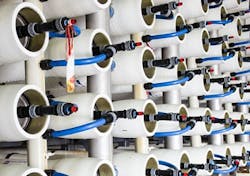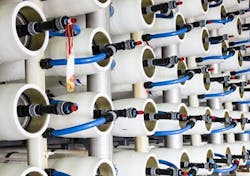Membranes now dominate 95 percent of desalination market
LONDON, UK – As filtration technology improves, membranes continue to dominate the global desalination market over thermal alternatives.
In 2017, membrane technology accounted for 2.2 million cubic meters per day (95.6 percent) of annual contracted capacity while thermal processes accounted for just 0.1 million m3/day (4.4 percent) during the same period.
Overall, theglobal desalination market continues to grow, marking the fourth year of continued growth following a slowdown in the mid-2000, according to data from the International Desalination Association and GWI.
Between mid-2017 and mid-2016, cumulative global contracted capacity increased by 14 percent. Furthermore, the total number of desalination plants worldwide across all categories stands at 19,372 (2017) versus 18,983 (2016).
According to the IDA, seawater desalination experienced its largest increase since 2014, driven largely by growth in the utility market in the Gulf, which is likely to retain the largest share of contracted seawater capacity for the foreseeable future.
However, significant awards for seawater desalination plants were also made in China, Singapore and Morocco during the past year.
Desalination of brackish water is also growing, with an increase of 29 percent in contracted capacity for the first half of 2017. The typical brackish water desalination plant is for smaller utilities and industrial users. China accounted for a large portion of growth in these plants, especially during the second half of 2016.
Large-scale projects around the Red Sea and Gulf account for much of the current recovery in the desalination market. However, the nature of these projects (most are large-scale) means that this region experiences highly variable swings in contracted capacity. A steadier source of contracts can be found in the Asia-Pacific region, where industrial projects dominate the reference list. At the half-way point in 2017, these two regions were almost equal in contracted capacity.
Both utility and industrial projects saw double-digit increase in capacity for the full year of 2016, driven by awards for industrial users in the latter part of the year.
For the first half of 2017, new utility capacity is down while industrial capacity has increased, due to the volume and size of utility awards in the Gulf during the first half of 2016 and the presence of several extra-large references for refining and petrochemical customers in the first half of 2017.
A closer look at the industrial sector reveals many interesting developments in the upstream oil and gas industry including several projects that may point to the future shape of the market in the offshore oil industry.
Commenting on the report findings, Dr David Lloyd Owen, managing director of consultancy, Envisager, told WWi: "Membranes have more or less taken over. The reservations about reliability and treated water quality seen at the start of the century have been overcome as the pre and post membrane treatment processes have been refined.
"The widespread adoption of industrial desalination demonstrates that industrial (or their governments) users are prepared to pay for their water. Desalination demonstrates that water is indeed not free and that somebody has to pay a premium where it is scarce."
###
Read more

